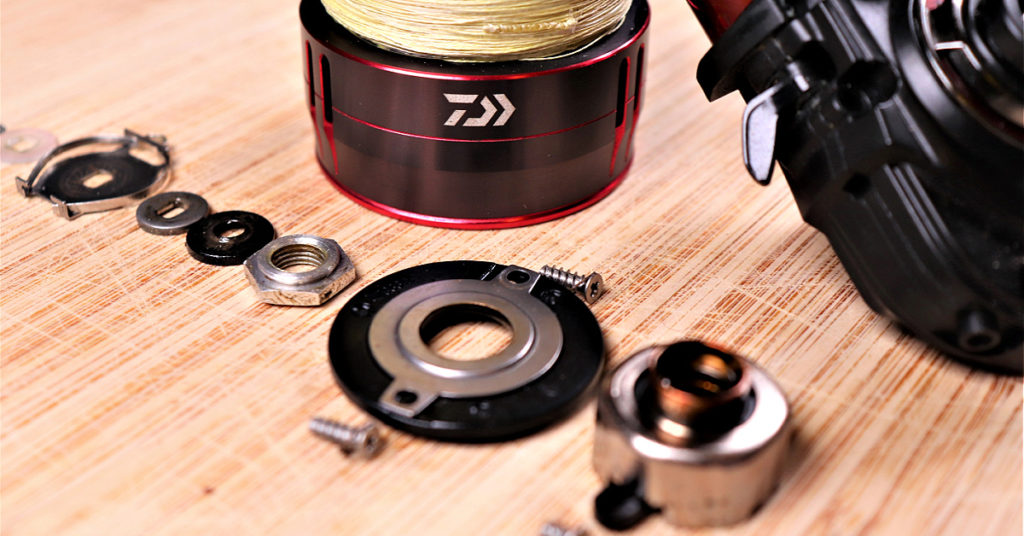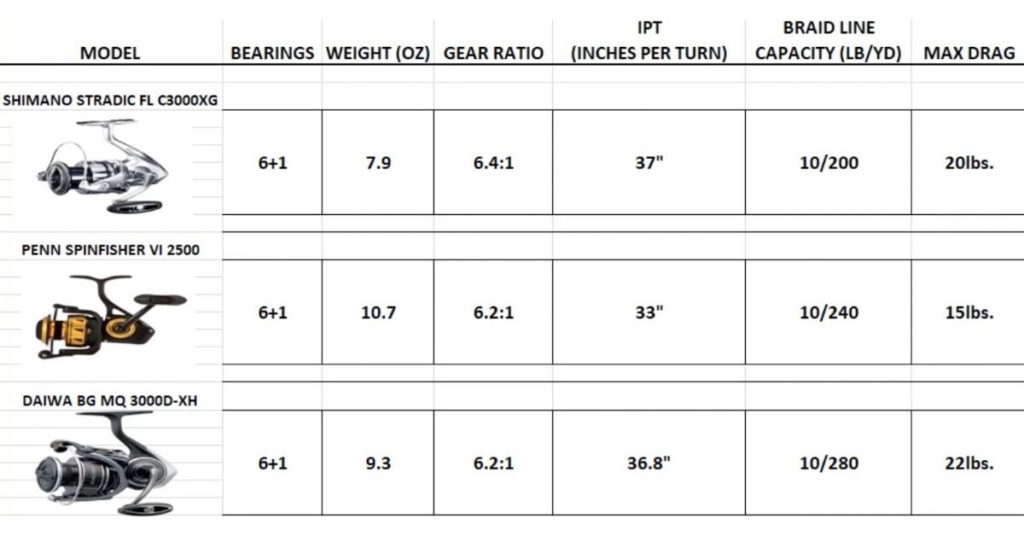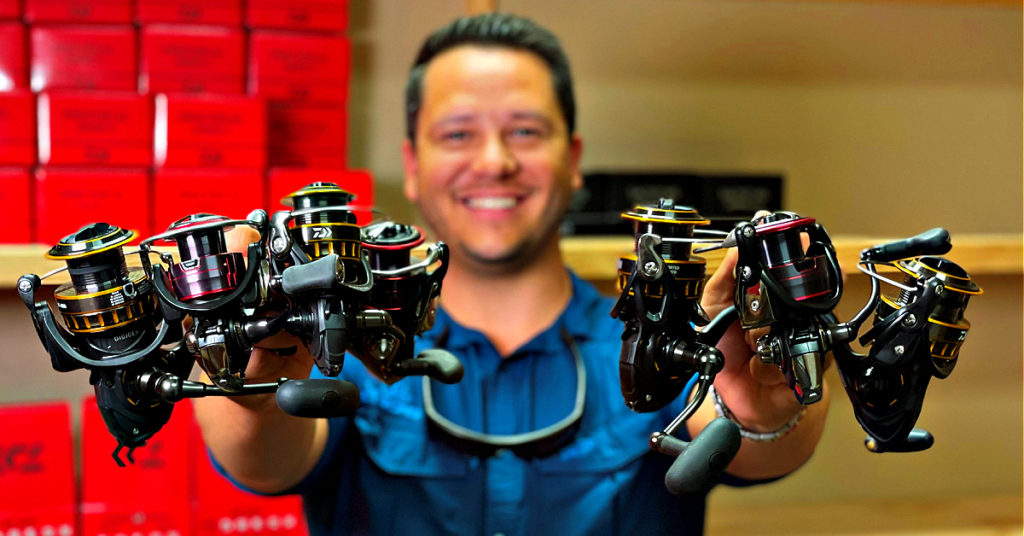The top $200 spinning reels comparison is here!!!
$200 spinning reels have proven to be extremely popular amongst inshore saltwater anglers.
But, of the top 3 major manufacturers, which spinning reel is best for you?
Learn all about the top $200 spinning reels comparison right here!
Top $200 Spinning Reels Comparison
Upfront, we believe all of the reels featured in this video are excellent choices for inshore anglers.
However, we do also believe that some reels perform better than others in given scenarios.
The three reels in this comparison come from Shimano, Penn, and Daiwa.
In this video, we are dissecting the Shimano Stradic FL 3000, the Penn Spinfisher VI 2500, and the Daiwa BG MQ 3000.
We’ve intentionally selected these three reels for our deep dive because of their similarities in certain aspects as well as differences that can create benefits in various fishing scenarios.
Levels Of Reel Sealing

Penn Spinfisher VI
In their Spinfisher VI, amongst other reels, Penn incorporates IPX ratings.
IPX or IP ratings is Ingress Protection.
Ingress Protection is a matter of how well solids, physical contaminants, or water make their way into what we are testing.
IP ratings are given in two numerical values.
The first number indicates how well a solid can pass through the body of the reel.
The second number indicates how well the body of the reel stands up to liquid contaminants.
In the case of spinning reels, you focus more on IPX which indicates water passing through the body because very few solids will ever come close to infiltrating your spinning reel.
Inshore spinning reels are already sealed to the point where salt and other physical contaminants have an extremely difficult time entering the body of the reel.
The IPX5 rating of the Spinfisher VI is very specific to the reel.
This means Penn tested the reels seals by blasting 12 liters of water per minute at the reel at a distance of 9-feet for at least a period of 3 minutes.
They then tore down the reel to observe water contamination and determine how much water entered the gearbox and drag stack.
Although the Spinfisher VI comes with an IPX5 score, that can significantly hinder other aspects of the reel.
For example, Penn may have sacrificed smoothness and refinement for emphasis on overall reel sealing.
There is a lot of grease and protectants packed into the reel that hinders the overall smoothness and refinement of the reel.
The Penn Spinfisher VI is a high-quality inshore spinning reel but it will not feel as smooth or refined using lighter inshore fishing tackle as the Daiwa or Shimano reels.
Overall, the Penn Spinfisher VI is a well-sealed reel that can defend against splashes and contaminants while also remaining relatively easy to maintain.
On the other hand, Daiwa and Shimano did not go the IPX route of determining the overall sealing capabilities of their reels.
Not every manufacturer uses an IPX rating to determine the level of sealing within their products.
Smoothness In A Reel

Smoothness within a reel can be subjective because it can vary based on different fishermen’s styles of fishing.
We define smoothness or refinement as how much effort is required to complete a turn with the handle and spin the rotor.
Arguably, the Shimano and Daiwa reels are the smoothest products of the three shown.
Both the Shimano and Daiwa reels spin effortlessly and feel extremely smooth.
In terms of the smoothness of a reel, you need to wonder how long the reel will stay smooth as well as what the manufacturers designed to create refinement within the reel.
The Daiwa and Shimano reels used in this demonstration have a moderate amount of sealing.
Daiwa BG MQ
As far as overall sealing is concerned, there are two major features on a reel that anglers are most attentive to being sealed.
How is the main gearbox protected from a sealing standpoint?
And, how are the spool and handle entry points sealed up?
These are the main areas where water could potentially penetrate your spinning reels.
Daiwa and Shimano slightly differ in their approach to external and internal sealants on their reels.
The handle on the Daiwa BG MQ is sealed using a preliminary rubber lipped-ring to protect the inner workings of the main gears.
The handle threads onto the bolt which is basically part of the main gear itself.
When the handle is threaded on the reel tight, water has to creep under the handle and then over the rubber lip and then back down again to the main gear.
It is extremely difficult for water to make its way into this reel.
Beneath the drag stack, Daiwa utilizes a small rubber cap covered in grease to further protect the reel.
This serves as a deterrent to prevent water or contaminants from entering the main shaft of the reel.
Further, the grease is also not inhibiting the smoothness of the drive train as the main shaft moves up and down with the rotor.

Shimano Stradic FL
A similar concept applies to the Shimano Stradic FL sealing techniques.
The handle has a similar approach by incorporating a threaded cap and rubber plunger to prevent contamination.
Moreover, Shimano incorporates the same rubber cap beneath the main shaft to prevent water from infiltrating the anti-reverse clutch.
Shimano uses a similar approach to Daiwa in that their reels are protected and sealed while also not inhibiting overall smoothness and performance of the reels.
Moving a step further, if water happens to pass through the main shaft to the main gear, the anti-reverse clutch can be compromised.
Shimano uses X-Protect and Core Protect to defend their reels.
Core Protect is a hydrophobic coating around the sensitive parts within the reel.
X-Protect is a labyrinth designed to create obstacles and barriers.
Daiwa MQ Series Reels
In the Daiwa MQ series spinning reels, there is a threaded piece that comes over the top of the anti-reverse clutch.
The threaded piece combined with rubber seals and compression aims to prevent contamination.
Both the Shimano Stradic FL and Daiwa BG MQ do a great job of sealing the anti-reverse clutch.
Line Roller Bearings
In past years, the roller bearings on the Shimano Stradic reels would blow out and become compromised.
Water and salt penetrated the line roller bearing and started to wear away at the bearing.
Shimano did not directly solve the issue but altered the assembly of the line roller bearing.
The objective of this was to make it easier for users to clean and maintain the line roller bearing.
The same concept also applies to the Penn Spinfisher VI but with less pieces needed.
But with all told, is having a bearing in the line roller an important feature on a spinning reel?
For anglers fishing for smaller species and need fluid line and drag movement, it is an important aspect to a reel.
However, for those inshore saltwater anglers using a 10-15+ lb test braided line, it is negligible.
As long as the line roller is spinning freely, the reel’s performance will not be impacted.
Gearing Materials
Across the board, aluminum main gears are smooth, precise, and extremely durable.
Daiwa, in particular, does a great job in how they align all of their main gears using what they refer to as “DigiGear” or Digital Gearing System.
DigiGear is bigger in diameter and thickness while at the same time fitting exactly into the pinion gear.
In simpler terms, Daiwa has taken time to learn how well they are crafting a zinc gear for their reels.
The Penn Spinfisher VI and Shimano Stradic FL have an aluminum main gear within the reel.
After careful evaluation, Daiwa’s use of zinc to craft the main gears edges out in front of aluminum main gears.
The sizing and combination of parts within Daiwa’s BG MQ cause it to be a powerhouse in terms of inshore spinning reels.
Pros & Cons
Although all three options included in this video are great for inshore saltwater fishing, there are pros and cons to be addressed.
Shimano Stradic FL
The Shimano Stradic FL excels in overall refinement and smoothness.
Shimano is known for its gearing.
Their reels are perfectly aligned and create smooth movement throughout the reel.
However, the line roller bearing on the Stradic is a major con.
The fact that Shimano did not replace the line roller bearing with a bushing leaves the line roller open to contamination.
Although Shimano has made it easier to replace a faulty bearing, it is still a con because you have to periodically maintain the part.
Furthermore, the grease Shimano uses within the main gears of its reels have affected overall spool performance.
Some anglers report a “sticky” spool or drag when a fish is burning line off their reel.
This is a result of the grease Shimano uses as well as their system for applying it in various places within the reel.
Penn Spinfisher VI
The Spinfisher VI is the best sealed out of the three reels discussed in this video.
More seals than an inshore saltwater angler might need but still very advantageous.
Also, you can easily maintain and repair many aspects of this reel right at home.
However, the reel is slightly heavier than most of its size and it is a downgrade in overall refinement.
Daiwa BG MQ
The Daiwa BG MQ is an ideal balance between refinement and sealing.
There are 9 overall seals within the reel and one monstrous main gear.
The main gear supports the power of the reel when you are battling a heavy load.
This reel checks off all the boxes in terms of not sacrificing power for refinement.
However, in the same light, these reels are not easy to maintain on your own.
Experienced anglers prefer to pop open reels and re-grease the main gear themselves.
At the moment, the ability to do this is not present in the BG MQ.
You would have to send this reel into a certified Daiwa service center or Daiwa directly to be repaired.
But the truth is, the Daiwa BG MQ doesn’t need a lot of maintenance to begin with because of its design.




Which Reel Is The “Best”?
After going over all the pros and cons of each reel, respectively, which one is the best choice for you?
At the end of the day, these are all quality reels and not one can be said to be the ‘winner’.
Let us know your own personal experiences with these reels down in the comments!
Top $200 Spinning Reels Comparison [VIDEO]
Do you want to know EXACTLY where you should fish this weekend? CLICK HERE




Conclusion
It is important to have a reel that works for you and fits the different types of fishing scenarios you most often find yourself in.
Daiwa, Shimano, and Penn design fantastic spinning reels that are fit to tackle any scenario an inshore angler might find themselves in.
Be sure to check out the specifics of each reel and choose the best fit for you!
Do you have any questions about this top $200 spinning reels comparison?
Let us know your thoughts and experiences down in the comments!!
And if you know someone who wants to learn more about the top $200 spinning reels comparison, please TAG or SHARE this with them!
P.S. Want access to our best fishing spots and tips, plus discounts to our online tackle store? Click here to join us in the Insider Club!
Related Articles:
- DAIWA BG VS. DAIWA BG MQ (WHICH ONE IS FOR YOU?)
- SHIMANO STRADIC FL SPINNING REEL: UNBOXING, SPECS, COMPARISON
- KNOW YOUR REEL SIZES (PROS & CONS OF 1000 VS 2500 VS 3000 REELS)










